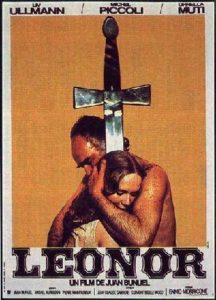 A 1975 French-Spanish-Italian co-production directed by Juan Luis Bunuel, a medieval set period piece dealing with necromancy and undying love. LEONOR is better than Bunuel’s previous genre effort, the dull haunted house chiller EXPULSION OF THE DEVIL, but it still leaves much to be desired.
A 1975 French-Spanish-Italian co-production directed by Juan Luis Bunuel, a medieval set period piece dealing with necromancy and undying love. LEONOR is better than Bunuel’s previous genre effort, the dull haunted house chiller EXPULSION OF THE DEVIL, but it still leaves much to be desired.
The basis of LEONOR was the early-1800s German tale “Wake Not the Dead,” attributed (wrongly, it’s been claimed) to Johann Ludwig Tieck. Other evident influences were the stories of Edgar Allan Poe, who appears to have bequeathed the title and much of the film’s imagery (such as a bricked-up crypt).
LEONOR was the second feature directed by Juan Luis Bunuel. Unlike his more famous father, Luis Bunuel never quite hit his stride as a filmmaker, as this film amply demonstrates. LEONOR did at least score an English dubbed U.S. release courtesy of New Line Cinema, followed by early eighties VHS distribution through Magnetic Video before largely vanishing into obscurity.
The medieval lord Richard’s beloved wife Leonor is dying. Despite the best efforts of Richard and a doctor acquaintance, who opens Leonor’s veins in an effort at reviving her, Leonor expires. The grief-stricken Richard marries the luscious young brunette Catherine, but he can’t help but pine after Leonor. Eventually Richard smashes open Leonor’s bricked-up crypt in a fit of madness, and meets a strange man who claims he can bring Leonor back to life–but that Richard would be better off leaving her at rest. Richard, however, insists his lost love be brought back.
As per his wishes, a living, breathing Leonor appears before him. She remembers little of her former life, but Richard is nonetheless determined to resume that life, so much so that he kills Catherine and drops her corpse into a well.
The undead Leonor is uncharacteristically antisocial, and inexplicably kills a little girl. This seems to revive her sexual appetite, as is proven the following night when she responds quite vociferously to Richard’s nocturnal advances. More children turn up dead, including Richard’s own, until one day Leonor is caught approaching a little girl tied to a tree who’s been used as bait by outraged villagers.
This, however, doesn’t deter the obsessed Richard from continuing his undead romance, even though it seems that Leonor is readying a new victim: Richard himself!
LEONOR’S air of deathless romance could have used a more lush and atmospheric visual treatment than the rather flat and uninspired visuals crafted by Juan Bunuel. Further damage is done by the technically proficient but overly melodramatic score by Ennio Morricone, and the fact that for some unfathomable reason Bunuel and his co-screenwriters elected to jettison the vampiric elements of the source tale, or at least render them so ambiguous they might as well be nonexistent (no blood drinking is never shown and Leonor is frequently seen cavorting in broad daylight). Why?
LEONOR’S air of deathless romance could have used a more lush and atmospheric visual treatment than the rather flat and uninspired visual…
The art direction, at least, is impressive, imparting a genuinely primitive feel to the proceedings, whose plague-ridden medieval setting feels entirely convincing. Equally effective is the performance of Liv Ullmann, who has an appropriately spectral, otherworldly air as Leonor. Michel Piccoli isn’t bad either as the lovesick (though none-too-sympathetic) Richard. It’s no wonder the proceedings work better as a supernaturally tinged account of dark romance than as a horror flick, which in all fairness may have been Juan Bunuel’s intent.
Vital Statistics
LEONOR
Arcadie Productions/Films 66/Goya Producciones Cinemtograficas
Director: Juan Luis Bunuel
Producer: Michel Piccoli
Screenplay: Roberto Bodegas, Juan Luis Bunuel, Jean
Claude Carriere, Clement Biddle Wood, Bernardino Zapponi
Cinematography: Luciano Tovoli
Editing: Pablo G. del Amo
Cast: Michel Piccoli, Liv Ullmann, Ornella Muti, Antonio Ferrandis, Jose Maria Prada, Angel del Pozo, Jose Guardiola, George Rigaud, Jose Maria Caffarel
